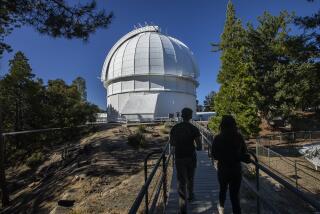Horace W. Babcock, 90; Invented Tools for Astronomical Measuring
- Share via
Horace Welcome Babcock, an astronomer and former director of the Pasadena-based Carnegie Observatories, died Friday in Santa Barbara. He was 90.
Babcock was born in Pasadena in 1912 and educated at Caltech and UC Berkeley. An inveterate inventor who sought to improve the ability to take astronomical measurements, he created a number of devices and observing techniques that are used to this day.
He joined the staff of the Mt. Wilson and Palomar observatories in 1946 and worked closely with his father, Harold Delos Babcock, an engineer and astronomical observer who had been one of the first members of the Mt. Wilson staff.
Together, the men constructed the first solar magnetograph, which allowed them to measure the general magnetic field of the sun.
Using another device of his own invention, Babcock was able to discover magnetic fields in more distant stars.
“He was an inventor all his life,” said George Preston, an astronomer and former director of the Carnegie Observatories, a scientific institution that operates a collection of telescopes.
Babcock also developed a “seeing monitor” that was used to judge the observing merits of various mountaintops selected as possible telescope sites.
In 1953, he proposed the technique of “adaptive optics” -- a system to deform telescope mirrors in real time to compensate for the fuzzing and dancing of images caused by distortions in the atmosphere. Adaptive optics has become a standard feature of modern telescopes.
Babcock was awarded several of astronomy’s most prestigious awards, including the Henry Draper, Eddington, Gold and Bruce medals and the Hale Prize.
From 1964 to 1978, he directed the Mt. Wilson and Palomar observatories.
Recognizing that the once-premier Mt. Wilson facility would soon be dwarfed by bigger telescopes in darker locations, Babcock pushed for the construction of an observatory in the Andes.
Though it was an unpopular idea at the time, the resulting Carnegie telescopes at Las Campanas in Chile’s Atacama desert are among the most powerful tools available for studying the center of our Milky Way galaxy.
“He was a stubborn man who ignored objections to what he was doing,” said Preston, who worked with Babcock for several decades. “Now we’re very glad he did.”
Babcock is survived by three children, Ken, Bruce and Ann; and a granddaughter.




